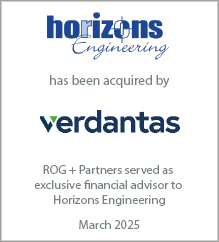Ian has spent the past twenty years working with hundreds of architecture, engineering and environmental consulting firms large and small throughout the U.S. and abroad with a focus on ownership planning, business valuation, ESOP advisory services, mergers & acquisitions, and strategic planning. Ian is a professionally trained and accredited business appraiser and holds the Accredited Senior Appraiser (ASA) designation with the American Society of Appraisers and is a certified merger & acquisition advisor (CM&AA) with the Alliance of Merger & Acquisition Advisors.
Financial Discipline and an Ownership Culture—Two Keys to a Successful A/E Practice
September 12, 2023
Over the last 25 years, I’ve had the pleasure of working with hundreds of A/E and environmental consulting firms of all sizes across the U.S. and abroad. Of the firms that have enjoyed sustained growth and consistent profitability through economic disruptions and over multiple generations of leadership, I’ve observed two key characteristics or “success variables” that have been present in almost all cases—disciplined financial management with timely reporting of key performance metrics, and a strong ownership culture.
Disciplined financial management includes timely financial reporting of profit & loss, balance sheet, key performance indicators, sales activity, contract backlog and other metrics. This would seem to be common sense, but you’d be shocked to know how many practices, even large ones, take months to close out financial periods and produce reliable and useful data. Firms with disciplined financial management also share performance data widely with management and staff, reward good performance and hold everyone accountable.
An ownership culture goes hand-in-hand with disciplined financial performance. This doesn’t necessarily mean an ESOP-owned company, but it DOES mean a company that provides ownership opportunities to its staff, and cultivates an environment that encourages staff to think and act like owners. Such companies often have large and widely distributed ownership structures, with a ratio of total staff to owners of under 8:1, and multiple levels of ownership with the goal of aligning leadership responsibility with ownership levels—the higher the responsibility, the greater the ownership.
Firms with a strong ownership culture are constantly developing the next generation of owners, and planning for the redemption of retiring shareholders. Creating liquidity for retiring shareholders requires consistent financial performance and strong internal demand for shares. The stock must be an attractive investment opportunity—priced fairly and providing a healthy return on investment to create such demand.
Conversely, firms that fail to cultivate a strong ownership culture put their future in jeopardy, and by extension the equity of their shareholders. Unfortunately, we’ve witnessed the ramifications of this many times. It might manifest itself in the firm contracting as valuable employees move on, or the owners being forced to sell externally under less than favorable circumstances, or in the worst case scenario, being forced to liquidate. In each of these cases the firm’s equity value is either diminished or lost altogether.
Ownership strategies and how they relate to growth and the creation of value in A/E firms is the theme of our annual conference we launched twelve years ago. If you’re interested in learning from industry experts and networking with other successful A/E executives, we welcome you to join us November 1-3 at the Ritz-Carlton Tiburon in beautiful Naples, Florida. For more information and to register, please visit https://conference.rog-partners.com.
Latest Perspective
A Shifting Outlook for the A/E Industry
For the A/E industry, 2024 ended with widespread optimism, strong contract backlogs, and record financial performance for many firms ...
Rusk O'Brien Gido + Partners, LLC








